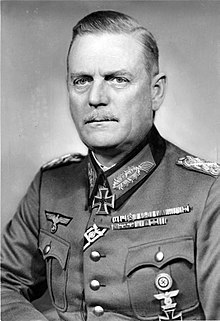Karl-Heinz Keitel
| Wilhelm Keitel | |
|---|---|

Wilhelm Keitel
|
|
| Nickname(s) | "Lakeitel" |
| Born |
22 September 1882 Helmscherode, German Empire |
| Died | 16 October 1946 (aged 64) Nuremberg, Allied-occupied Germany |
| Allegiance |
|
| Service/branch | Wehrmacht |
| Years of service | 1901–1945 |
| Rank | Generalfeldmarschall |
| Commands held | OKW |
| Battles/wars |
World War I World War II |
| Awards | Knight's Cross of the Iron Cross |
| Spouse(s) | Lisa Fontaine (m. 1909) (1887-1959) |
| Relations |
Bodewin Keitel (brother) Karl-Heinz Keitel (eldest son) |
| Signature | |
Wilhelm Keitel (22 September 1882 – 16 October 1946) was a German field marshal who served as chief of the Oberkommando der Wehrmacht (Supreme Command of the Armed Forces, the OKW) for most of World War II. Following the war, Keitel was charged with war crimes and crimes against humanity by the International Military Tribunal at Nuremberg. He was found guilty, sentenced to death and executed in 1946. He was the third highest-ranking German officer to be tried at Nuremberg.
Keitel was born in the village of Helmscherode near Gandersheim in the Duchy of Brunswick, the eldest son of Carl Keitel (1854–1934), a middle class landowner, and his wife Apollonia Vissering (1855–1888). After he completed his education at gymnasium in Göttingen, his plan to take over his family's estates foundered on his father's resistance. Instead, he embarked on a military career in 1901, becoming an officer cadet of the Prussian Army. As a commoner he did not join the cavalry, but the mounted 46th Lower-Saxon Field Artillery Regiment in Wolfenbüttel, serving as adjutant from 1908.
On 18 April 1909, Keitel married Lisa Fontaine, a wealthy landowner's daughter at Wülfel near Hanover. Together they had six children, one of whom died in infancy. His eldest son, Karl-Heinz Keitel went on to serve as a divisional commander in the Waffen-SS. During World War I, Keitel served on the Western Front with his artillery regiment and took part in the fighting in Flanders, where he was severely wounded in his right forearm by a shell fragment. Elevated to the rank of a captain, Keitel quickly recovered, and in 1915 posted to the General Staff of the 19th Reserve Infantry Division. He later went on to fight in the First Battle of the Marne, the Battle of Verdun, and in the Battle of Passchendaele, being awarded the Iron Cross 2nd and 1st Class.
...
Wikipedia
